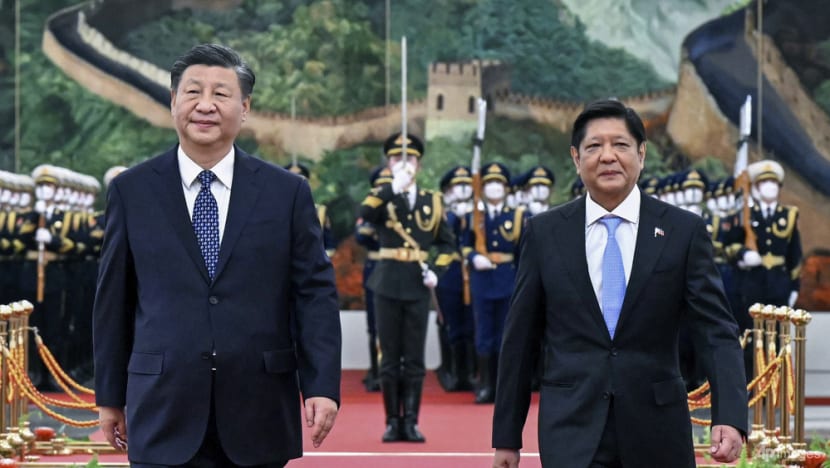Commentary: The Philippines walks a tightrope with Chinese aid
Manila wants to assert its sovereignty, but it also needs roads, bridges and power plants. Pragmatism, not ideology, is driving development finance decisions, say the Lowy Institute’s Alexandre Dayant and Grace Stanhope.

In this photo released by Xinhua News Agency, Chinese President Xi Jinping and visiting Philippine President Ferdinand Marcos Jr appear together during a welcoming ceremony at the Great Hall of the People in Beijing on Jan 4, 2023. (Shen Hong/Xinhua via AP, File)
SYDNEY: At last week’s Raisina Dialogue in New Delhi, the Philippines’ Armed Forces Chief didn’t mince words, calling on India and South Korea to join an Indo-Pacific “squad” to push back against China’s aggressive tactics in the South China Sea.
But while Manila hardens its security posture, it’s also receiving more development money from Beijing than ever before. So, what gives?
For most of the past decade, the Philippines has been one of Southeast Asia’s most cautious players when it comes to Chinese development finance, even as its infrastructure, education and healthcare sectors cry out for investment.
From 2015 to 2022, China accounted for just 1 per cent of total official development finance to the country, the lowest share among Southeast Asian nations. Unlike neighbours such as Laos or Cambodia, Manila has long preferred traditional partners including Japan, the Asian Development Bank and the World Bank.
RODRIGO DUTERTE STEERED CLOSER TO CHINA
But as president, Rodrigo Duterte sought to flip the script. Elected in 2016, Duterte cast aside decades of wariness and steered the Philippines closer to China, hoping to trade diplomacy for development.
In just six years, he signed more than US$28 billion in aid commitments with Beijing, more than triple Japan’s total over the same period. At the height of this pivot, Chinese development finance made up 40 per cent of all new aid commitments to the country.
It could have marked a turning point. Yet, in practice, the grand promises of China-backed megaprojects faltered, mostly because Filipino society and institutions pushed back.
Concerns over environmental impacts, governance standards and sovereignty fuelled resistance to Chinese projects. And with the South China Sea dispute simmering in the background, public trust in Beijing remained low.
Despite the flashy numbers, only 1.5 per cent of China’s promised funds were ever delivered – the lowest in ASEAN – largely due to prolonged negotiations and concerns over several megaprojects.
This gap between promise and delivery highlights something crucial: Development finance isn’t just about the supply of the money, it’s about trust, capacity, and choice – which together form demand. In our latest Lowy Institute Analysis, Hedging Bets: Southeast Asia’s Approach to China’s Aid, we identify three distinct Southeast Asian modes of engagement with Chinese development finance: Constrained, restrained, and opportunistic.
The Philippines straddles the line between restrained and carefully opportunistic, actively diversifying its development partners to avoid overreliance on China, especially amid ongoing territorial disputes, but also remaining cautiously open to Chinese funding when it aligns with interests.
A SELECTIVE APPROACH UNDER FERDINAND MARCOS JR
Under President Ferdinand Marcos Jr, the pendulum initially swung further away from Beijing.
In 2022, his administration cancelled three major railway projects backed by China, citing implementation delays and rising tensions in the South China Sea, signalling a return towards a more defensive and restrained stance that echoed his strong public criticism of Beijing over the maritime disputes.
But that’s not the full story. Preliminary data from the upcoming 2025 Lowy Institute Southeast Asia Aid Map shows Chinese disbursements have gradually increased under Marcos compared to his predecessor – albeit from a low base – driven by new China Eximbank infrastructure loans supporting Marcos’ “Build Better More” agenda, totalling around US$200 million so far, with more potentially on the horizon.
This suggests the Marcos government is now cautiously steering towards a more selective, opportunistic approach: Carefully accepting Chinese funding when it fits the country’s needs, while pushing back hard on strategic and security issues.
It’s a tightrope walk. As China becomes more assertive in the region and the West cuts back on global aid spending, the Philippines finds itself with fewer alternatives.
Manila wants to assert its sovereignty, but it also needs roads, bridges and power plants. Pragmatism, not ideology, is driving development finance decisions.
The Philippines’ future will hinge on its ability to continue walking this fine line: Benefiting from China’s development support without being boxed in by Beijing’s strategic agenda. That’s no easy task. But in a region increasingly defined by economic opportunity and geopolitical tension, it may be the only option left.
Alexandre Dayant is a senior economist and Deputy Director of the Lowy Institute’s Indo-Pacific Development Centre. Grace Stanhope is a Research Associate at the same centre. This commentary first appeared on the Lowy Institute's blog, Interpreter.
















